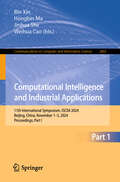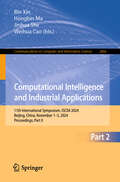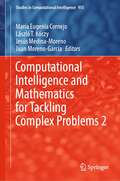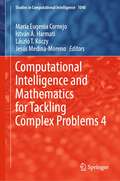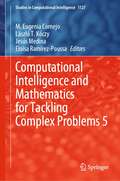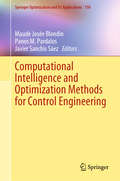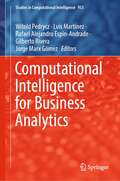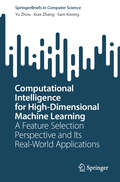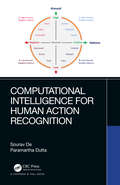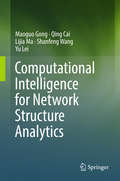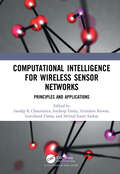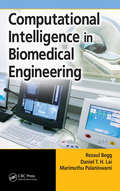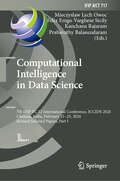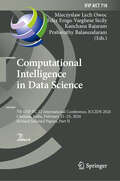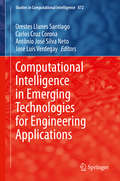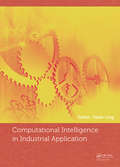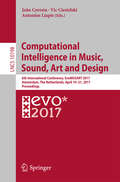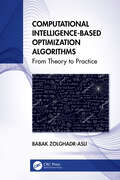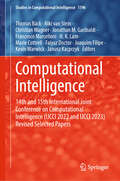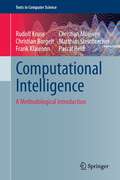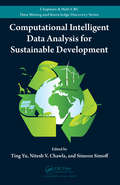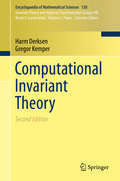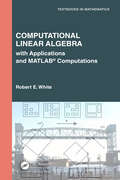- Table View
- List View
Computational Intelligence and Industrial Applications: 11th International Symposium, ISCIIA 2024, Beijing, China, November 1–5, 2024, Proceedings, Part I (Communications in Computer and Information Science #2465)
by Hongbin Ma Weihua Cao Jinhua She Bin XinThis two-volume set CCIS 2465-2466, constitutes of the proceedings of 11th International Symposium on Computational Intelligence and Industrial Applications, ISCIIA 2024, held in Beijing, China, during November 1–5, 2024. The 55 full papers and 5 short papers included in this volume were carefully reviewed and selected from 135 submissions. The topics cover the following fields connected to computational intelligence and intelligent informatics: intelligent information processing, pattern recognition and computer vision, intelligent optimization and decision-making, advanced control, multi-agent systems, robotics and various applications of computational intelligence methods such as neural networks, fuzzy reasoning, evolutionary computing, machine learning and<span style="font-size: 12.0pt; lin
Computational Intelligence and Industrial Applications: 11th International Symposium, ISCIIA 2024, Beijing, China, November 1–5, 2024, Proceedings, Part II (Communications in Computer and Information Science #2466)
by Hongbin Ma Weihua Cao Jinhua She Bin XinThis two-volume set CCIS 2465-2466, constitutes of the proceedings of 11th International Symposium on Computational Intelligence and Industrial Applications, ISCIIA 2024, held in Beijing, China, during November 1–5, 2024. The 55 full papers and 5 short papers included in this volume were carefully reviewed and selected from 135 submissions. The topics cover the following fields connected to computational intelligence and intelligent informatics: intelligent information processing, pattern recognition and computer vision, intelligent optimization and decision-making, advanced control, multi-agent systems, robotics and various applications of computational intelligence methods such as neural networks, fuzzy reasoning, evolutionary computing, machine learning and<span style="font-size: 12.0pt; line-heigh
Computational Intelligence and Mathematics for Tackling Complex Problems 2 (Studies in Computational Intelligence #955)
by László T. Kóczy María Eugenia Cornejo Jesús Medina-Moreno Juan Moreno-GarcíaThis book collects the final versions of the highest quality papers presented at the conference 11th European Symposium on Computational Intelligence and Mathematics held on October 2–5, 2019, in Toledo (Spain). The conjugation of computational sciences with different mathematical tools is essential in order to solve different challenges that arise in a wide-ranging knowledge areas. Nowadays, many promising research lines are being developed in this direction from the theoretical and applicational perspectives. In this publication, computational intelligence and mathematics are combined in interesting research works that aim to give answers to complex real problems. Moreover, the technical program of this conference included four excellent keynote speeches, given by Prof. José Luis Verdegay (Guidelines to solve Decision Making Problems), Prof. Joao Paulo Carvalho (Recommender Systems: Using Fuzzy Fingerprints for ``Proper'' Recommendations), Dr. Andreja Tepavcevic (Special lattice valued structures and approximate solutions of linear equations), and Prof. Juan Moreno-Garcia (Generating linguistic descriptions using Linguistic Petri Nets).
Computational Intelligence and Mathematics for Tackling Complex Problems 4 (Studies in Computational Intelligence #1040)
by László T. Kóczy María Eugenia Cornejo Jesús Medina-Moreno István Á. HarmatiThe recent book of the series continues the collection of articles dealing with the important and efficient combination of traditional and novel mathematical approaches with various computational intelligence techniques, with a stress of fuzzy systems, and fuzzy logic. Complex systems are theoretically intractable, as the need of time and space resources (e.g., computer capacity) exceed any implementable extent. How is it possible that in the practice, such problems are usually manageable with an acceptable quality by human experts? They apply expert domain knowledge and various methods of approximate modeling and corresponding algorithms. Computational intelligence is the mathematical tool box that collects techniques which are able to model such human interaction, while (new) mathematical approaches are developed and used everywhere where the complexity of the sub-task allows it. The innovative approaches in this book give answer to many questions on how to solve “unsolvable” problems.
Computational Intelligence and Mathematics for Tackling Complex Problems 5 (Studies in Computational Intelligence #1127)
by László T. Kóczy Jesús Medina Eloísa Ramírez-Poussa M. Eugenia CornejoThis book is focused on connecting two interesting research areas, mathematics and computational intelligence, by means of appealing contributions devoted to give solutions to different challenges of the current technological age.It continues the collection of articles dealing with the important and efficient combination of these both areas, with a stress of fuzzy systems and fuzzy logic. It also includes relevant papers on the development and application of mathematics, artificial intelligence, and automatic reasoning tools to Digital Forensics, which have been developed within the framework of the COST Action DigForASP-CA17124 (digforasp.uca.es).
Computational Intelligence and Optimization Methods for Control Engineering (Springer Optimization and Its Applications #150)
by Panos M. Pardalos Maude Josée Blondin Javier Sanchis SáezThis volume presents some recent and principal developments related to computational intelligence and optimization methods in control. Theoretical aspects and practical applications of control engineering are covered by 14 self-contained contributions. Additional gems include the discussion of future directions and research perspectives designed to add to the reader’s understanding of both the challenges faced in control engineering and the insights into the developing of new techniques. With the knowledge obtained, readers are encouraged to determine the appropriate control method for specific applications.
Computational Intelligence based Hyperspectral Image Processing: Volume 1 (Intelligent Systems Reference Library #268)
by Ajith Abraham Anu BajajHyperspectral imaging has revolutionized fields ranging from environmental monitoring to medical diagnostics by providing detailed spectral information across vast datasets. However, the complexity and high dimensionality of hyperspectral data pose significant challenges in analysis and interpretation. “Computational Intelligence based Hyperspectral Image Processing" is a comprehensive guide to overcoming these challenges by leveraging the latest computational intelligence techniques. This Volume comprises of 9 chapters that illustrate how computational intelligence-based solutions has been successful to improve efficiency and productivity, quality control, and in enhancing innovation and competitiveness with cost reduction. This book is an essential resource for researchers, professionals, and students working in remote sensing, image processing, and computational intelligence. Whether you're new to the field or looking to deepen your expertise, this book provides the tools and knowledge you need to succeed in the fast-evolving world of hyperspectral imaging.
Computational Intelligence for Business Analytics (Studies in Computational Intelligence #953)
by Witold Pedrycz Jorge Marx Gómez Luis Martínez Rafael Alejandro Espin-Andrade Gilberto RiveraCorporate success has been changed by the importance of new developments in Business Analytics (BA) and furthermore by the support of computational intelligence- based techniques. This book opens a new avenues in these subjects, identifies key developments and opportunities. The book will be of interest for students, researchers and professionals to identify innovative ways delivered by Business Analytics based on computational intelligence solutions. They help elicit information, handle knowledge and support decision-making for more informed and reliable decisions even under high uncertainty environments.Computational Intelligence for Business Analytics has collected the latest technological innovations in the field of BA to improve business models related to Group Decision-Making, Forecasting, Risk Management, Knowledge Discovery, Data Breach Detection, Social Well-Being, among other key topics related to this field.
Computational Intelligence for High-Dimensional Machine Learning: A Feature Selection Perspective and Its Real-World Applications (SpringerBriefs in Computer Science)
by Yu Zhou Xiao Zhang Sam KwongThis book focuses on the modelling and optimization aspects of the feature selection problem through computational intelligence methods in complex, high-dimensional supervised machine learning. To aid readers in conducting research in this field, it covers fundamental concepts and state-of-the-art algorithms. This book also provides a detailed insight into applying these algorithms into real-world applications. The authors begin by introducing the definition high-dimensional machine learning (ML) problems and the challenges they pose. Subsequently, they delve into dimension reduction methods for high-dimensional ML, including global and local feature selection (FS) techniques. This book also comprehensively presents computational intelligence methods such as evolutionary computation and deep neural networks for FS, supported by both theoretical and empirical evidence. Furthermore, this book explores real-world scenario applications involving high-dimensional ML, particularly in the context of smart cities, bioinformatics and industrial informatics. This book is a suitable read for postgraduates and researchers who are interested in the research areas of computational intelligence, soft computing, machine learning and deep learning. Professionals and practitioners within these related fields will also benefit from this book.
Computational Intelligence for Human Action Recognition (Chapman & Hall/CRC Computational Intelligence and Its Applications)
by Sourav De and Paramartha DuttaHuman Action Recognition is a challenging area presently. The vigor of research effort directed towards this domain is self indicative of this. With the ever-increasing involvement of Computational Intelligence in our day to day applications, the necessity of human activity recognition has been able to make its presence felt to the concerned research community. The primary drive of such an effort is to equip the computing system capable of recognizing and interpreting human activities from posture, pose, gesture, facial expression etc. The intent of human activity recognition is a formidable component of cognitive science in which researchers are actively engaged of late. Features: A systematic overview of the state-of-the-art in computational intelligence techniques for human action recognition. Emphasized on different intelligent techniques to recognize different human actions. Discussed about the automation techniques to handle human action recognition. Recent research results and some pointers to future advancements in this arena. In the present endeavour the editors intend to come out with a compilation that reflects the concerns of relevant research community. The readers would be able to come across some of the latest findings of active researchers of the concerned field. It is anticipated that this treatise shall be useful to the readership encompassing students at undergraduate and postgraduate level, researchers active as well as aspiring, not to speak of the senior researchers.
Computational Intelligence for Network Structure Analytics
by Maoguo Gong Qing Cai Lijia Ma Shanfeng Wang Yu LeiThis book presents the latest research advances in complex network structure analytics based on computational intelligence (CI) approaches, particularly evolutionary optimization. Most if not all network issues are actually optimization problems, which are mostly NP-hard and challenge conventional optimization techniques. To effectively and efficiently solve these hard optimization problems, CI based network structure analytics offer significant advantages over conventional network analytics techniques. Meanwhile, using CI techniques may facilitate smart decision making by providing multiple options to choose from, while conventional methods can only offer a decision maker a single suggestion. In addition, CI based network structure analytics can greatly facilitate network modeling and analysis. And employing CI techniques to resolve network issues is likely to inspire other fields of study such as recommender systems, system biology, etc. , which will in turn expand CI's scope and applications. As a comprehensive text, the book covers a range of key topics, including network community discovery, evolutionary optimization, network structure balance analytics, network robustness analytics, community-based personalized recommendation, influence maximization, and biological network alignment. Offering a rich blend of theory and practice, the book is suitable for students, researchers and practitioners interested in network analytics and computational intelligence, both as a textbook and as a reference work.
Computational Intelligence for Wireless Sensor Networks: Principles and Applications
by Sandip Kumar ChaurasiyaComputational Intelligence for Wireless Sensor Networks: Principles and Applications provides an integrative overview of the computational intelligence (CI) in wireless sensor networks and enabled technologies. It aims to demonstrate how the paradigm of computational intelligence can benefit Wireless Sensor Networks (WSNs) and sensor-enabled technologies to overcome their existing issues. This book provides extensive coverage of the multiple design challenges of WSNs and associated technologies such as clustering, routing, media access, security, mobility, and design of energy-efficient network operations. It also describes various CI strategies such as fuzzy computing, evolutionary computing, reinforcement learning, artificial intelligence, swarm intelligence, teaching learning-based optimization, etc. It also discusses applying the techniques mentioned above in wireless sensor networks and sensor-enabled technologies to improve their design. The book offers comprehensive coverage of related topics, including: Emergence of intelligence in wireless sensor networks Taxonomy of computational intelligence Detailed discussion of various metaheuristic techniques Development of intelligent MAC protocols Development of intelligent routing protocols Security management in WSNs This book mainly addresses the challenges pertaining to the development of intelligent network systems via computational intelligence. It provides insights into how intelligence has been pursued and can be further integrated in the development of sensor-enabled applications.
Computational Intelligence in Biomedical Engineering
by Marimuthu Palaniswami Rezaul Begg Daniel T.H. LaiAs in many other fields, biomedical engineers benefit from the use of computational intelligence (CI) tools to solve complex and non-linear problems. The benefits could be even greater if there were scientific literature that specifically focused on the biomedical applications of computational intelligence techniques. The first comprehensive field-
Computational Intelligence in Data Science: 7th IFIP TC 12 International Conference, ICCIDS 2024, Chennai, India, February 21–23, 2024, Revised Selected Papers, Part I (IFIP Advances in Information and Communication Technology #717)
by Mieczyslaw Lech Owoc Kanchana Rajaram Felix Enigo Varghese Sicily Prabavathy BalasundaramThese two-volume set IFIP AICT 717 and 718 constitutes the refereed post-conference proceedings of the 7th International Conference on Computational Intelligence in Data Science, ICCIDS 2024, held in Chennai, India, during February 21–23, 2024. The 63 full papers and 9 short papers presented in these proceedings were carefully reviewed and selected from 259 submissions. The conference papers are organized in following topical sections: Part I: Applications of AI/ML in Natural Language Processing; and Applications of AI/ML in Image Processing. Part II: Applications of AI/ML in KDM, Cloud Computing & Security; Data Analytics; and Applications of ML.
Computational Intelligence in Data Science: 7th IFIP TC 12 International Conference, ICCIDS 2024, Chennai, India, February 21–23, 2024, Revised Selected Papers, Part II (IFIP Advances in Information and Communication Technology #718)
by Mieczyslaw Lech Owoc Kanchana Rajaram Felix Enigo Varghese Sicily Prabavathy BalasundaramThese two-volume set IFIP AICT 717 and 718 constitutes the refereed post-conference proceedings of the 7th International Conference on Computational Intelligence in Data Science, ICCIDS 2024, held in Chennai, India, during February 21–23, 2024. The 63 full papers and 9 short papers were presented in these proceedings were carefully reviewed and selected from 259 submissions. The conference papers are organized in topical sections on: Part I - Applications of AI/ML in Natural Language Processing; and Applications of AI/ML in Image Processing. Part II - Applications of AI/ML in KDM, Cloud Computing & Security; Data Analytics; and Applications of ML.
Computational Intelligence in Emerging Technologies for Engineering Applications (Studies in Computational Intelligence #872)
by Orestes Llanes Santiago José Luis Verdegay Carlos Cruz Corona Antônio José Silva NetoThis book explores applications of computational intelligence in key and emerging fields of engineering, especially with regard to condition monitoring and fault diagnosis, inverse problems, decision support systems and optimization. These applications can be beneficial in a broad range of contexts, including: water distribution networks, manufacturing systems, production and storage of electrical energy, heat transfer, acoustic levitation, uncertainty and robustness of infinite-dimensional objects, fatigue failure prediction, autonomous navigation, nanotechnology, and the analysis of technological development indexes. All applications, mathematical and computational tools, and original results are presented using rigorous mathematical procedures. Further, the book gathers contributions by respected experts from 22 different research centers and eight countries: Brazil, Cuba, France, Hungary, India, Japan, Romania and Spain. The book is intended for use in graduate courses on applied computation, applied mathematics, and engineering, where tools like computational intelligence and numerical methods are applied to the solution of real-world problems in emerging areas of engineering.
Computational Intelligence in Industrial Application: Proceedings of the 2014 Pacific-Asia Workshop on Computer Science in Industrial Application (CIIA 2014), Singapore, December 8-9, 2014
by Yanlv LingThese proceedings of the 2014 Pacific-Asia Workshop on Computational Intelligence in Industrial Application (CIIA 2014) include 81 peer-reviewed papers. The topics covered in the book include: (1) Computer Intelligence, (2) Application of Computer Science and Communication, (3) Industrial Engineering, Product Design and Manufacturing, (4) Automatio
Computational Intelligence in Machine Learning: Proceedings of the 3rd International Conference ICCIML 2023 (Lecture Notes in Electrical Engineering #1400)
by Amit Kumar Vinit Kumar Gunjan Jacek M. Zurada S. N. SinghThis book features selected proceedings from the International Conference on Computational Intelligence in Machine Learning (ICCIML 2023). It covers the latest research trends and developments in various fields, including machine learning, smart cities, the Internet of Things (IoT), artificial intelligence, cyber-physical systems, cybernetics, data science, neural networks, and cognition, among others. The book also emphasizes the comprehensive nature of computational intelligence, artificial intelligence, machine learning, and deep learning by highlighting their roles in modeling, identification, optimization, prediction, forecasting, and controlling future intelligent systems. This volume serves as a valuable resource for researchers in both academia and industry, offering in-depth insights from fundamental research contributions. It focuses on methodological and application perspectives, enhancing the understanding of AI and ML approaches and their capabilities in addressing a diverse range of problems across various industries and real-world applications.
Computational Intelligence in Music, Sound, Art and Design: 6th International Conference, EvoMUSART 2017, Amsterdam, The Netherlands, April 19–21, 2017, Proceedings (Lecture Notes in Computer Science #10198)
by João Correia, Vic Ciesielski and Antonios LiapisThis book constitutes the refereed proceedings of the 6th International Conference on Evolutionary Computation in Combinatorial Optimization, EvoMUSART 2017, held in Amsterdam, The Netherlands, in April 2017, co-located with the Evo*2017 events EuroGP, EvoCOP and EvoApplications. The 24 revised full papers presented were carefully reviewed and selected from 29 submissions. The papers cover a wide range of topics and application areas, including: generative approaches to music, graphics, game content, and narrative; music information retrieval; computational aesthetics; the mechanics of interactive evolutionary computation; computer-aided design; and the art theory of evolutionary computation.
Computational Intelligence-based Optimization Algorithms: From Theory to Practice
by Babak Zolghadr-AsliComputational intelligence-based optimization methods, also known as metaheuristic optimization algorithms, are a popular topic in mathematical programming. These methods have bridged the gap between various approaches and created a new school of thought to solve real-world optimization problems. In this book, we have selected some of the most effective and renowned algorithms in the literature. These algorithms are not only practical but also provide thought-provoking theoretical ideas to help readers understand how they solve optimization problems. Each chapter includes a brief review of the algorithm’s background and the fields it has been used in. Additionally, Python code is provided for all algorithms at the end of each chapter, making this book a valuable resource for beginner and intermediate programmers looking to understand these algorithms.
Computational Intelligence: 14th and 15th International Joint Conference on Computational Intelligence (IJCCI 2022 and IJCCI 2023) Revised Selected Papers (Studies in Computational Intelligence #1196)
by Thomas Bäck Kevin Warwick Joaquim Filipe Janusz Kacprzyk Christian Wagner Marie Cottrell Jonathan M. Garibaldi Niki Van Stein Francesco Marcelloni H. K. Lam Faiyaz DoctorThe present book includes a set of selected revised and extended versions of the best papers presented at the 14th and 15th International Joint Conference on Computational Intelligence (IJCCI 2022 and IJCCI 2023) – held respectively in Valletta, Malta, between October 24–26, 2022 and Rome, Italy, between November 13–15. We focus on three outstanding fields of Computational Intelligence through the selected panel, namely: Evolutionary Computation, Fuzzy Computation and Neural Computation. Beside presenting the recent advances of the selected areas, the book aims to aggregate new and innovative solutions for confirmed researchers, and on the other hand to provide a source of information and/or inspiration for young interested researchers or learners in the ever expanding and current filed of Computational Intelligence. It could constitute a precious provision of knowledge for individual researchers as well as represent a valuable sustenance for collective use in academic libraries (ofuniversities and engineering schools) relating innovative techniques in various fields of applications.
Computational Intelligence: A Methodological Introduction (Texts in Computer Science #739)
by Frank Klawonn Matthias Steinbrecher Rudolf Kruse Pascal Held Christian Borgelt Christian MoewesThis clearly-structured, classroom-tested textbook/reference presents a methodical introduction to the field of CI. Providing an authoritative insight into all that is necessary for the successful application of CI methods, the book describes fundamental concepts and their practical implementations, and explains the theoretical background underpinning proposed solutions to common problems. Only a basic knowledge of mathematics is required. Features: provides electronic supplementary material at an associated website, including module descriptions, lecture slides, exercises with solutions, and software tools; contains numerous examples and definitions throughout the text; presents self-contained discussions on artificial neural networks, evolutionary algorithms, fuzzy systems and Bayesian networks; covers the latest approaches, including ant colony optimization and probabilistic graphical models; written by a team of highly-regarded experts in CI, with extensive experience in both academia and industry.
Computational Intelligent Data Analysis for Sustainable Development (Chapman & Hall/CRC Data Mining and Knowledge Discovery Series)
by Ting Yu Simeon Simoff Nitesh V. ChawlaGoing beyond performing simple analyses, researchers involved in the highly dynamic field of computational intelligent data analysis design algorithms that solve increasingly complex data problems in changing environments, including economic, environmental, and social data. Computational Intelligent Data Analysis for Sustainable Development present
Computational Invariant Theory (Encyclopaedia of Mathematical Sciences #130)
by Harm Derksen Gregor KemperThis book is about the computational aspects of invariant theory. Of central interest is the question how the invariant ring of a given group action can be calculated. Algorithms for this purpose form the main pillars around which the book is built. There are two introductory chapters, one on Gröbner basis methods and one on the basic concepts of invariant theory, which prepare the ground for the algorithms. Then algorithms for computing invariants of finite and reductive groups are discussed. Particular emphasis lies on interrelations between structural properties of invariant rings and computational methods. Finally, the book contains a chapter on applications of invariant theory, covering fields as disparate as graph theory, coding theory, dynamical systems, and computer vision. The book is intended for postgraduate students as well as researchers in geometry, computer algebra, and, of course, invariant theory. The text is enriched with numerous explicit examples which illustrate the theory and should be of more than passing interest. More than ten years after the first publication of the book, the second edition now provides a major update and covers many recent developments in the field. Among the roughly 100 added pages there are two appendices, authored by Vladimi r Popov, and an addendum by Norbert A'Campo and Vladimir Popov.
Computational Linear Algebra: with Applications and MATLAB® Computations (Textbooks in Mathematics)
by Robert E. WhiteCourses on linear algebra and numerical analysis need each other. Often NA courses have some linear algebra topics, and LA courses mention some topics from numerical analysis/scientific computing. This text merges these two areas into one introductory undergraduate course. It assumes students have had multivariable calculus. A second goal of this text is to demonstrate the intimate relationship of linear algebra to applications/computations.A rigorous presentation has been maintained. A third reason for writing this text is to present, in the first half of the course, the very important topic on singular value decomposition, SVD. This is done by first restricting consideration to real matrices and vector spaces. The general inner product vector spaces are considered starting in the middle of the text.The text has a number of applications. These are to motivate the student to study the linear algebra topics. Also, the text has a number of computations. MATLAB® is used, but one could modify these codes to other programming languages. These are either to simplify some linear algebra computation, or to model a particular application.
